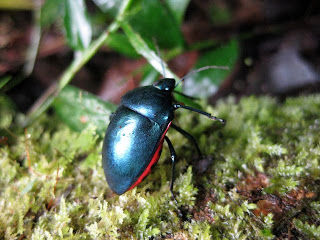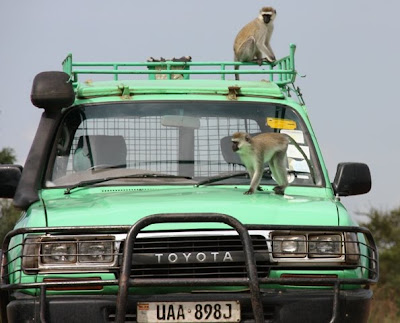May 5, 2010
While preparing for my year in Uganda, I heard about many other researchers who developed malaria or other ailments while studying in Africa. I was always curious to learn the details of what it was like for these researchers to be sick in a foreign country – so I've decided to write a post about my experience with malaria (and/or other African illnesses).
On one of the last days of March, I went out to the forest and followed chimps like any other day here; I had a mild headache but didn't think much about it. That night when I got home I was preparing my field bag for the following day when out of nowhere – I felt incredibly sick. I started shivering and quickly developed a mild fever. By the next morning (Day 2), I had a 101 fever, a killer headache, and my lower back was incredibly painful. Dean and I (with the help of other Ugandans and researchers) decided that I probably had malaria (despite the fact that I take Malarone prophylaxes daily and sleep under a bed net…) so I quickly started taking anti-malarials. On Day 3, I still had a fever – but I was starting to feel better. I could get out of bed and walk around…I was beginning to think that I had dodged malaria before it got really bad. But then, Day 4 hit me like a brick…all my symptoms intensified and I could not find a single position that felt comfortable for my back. I could hardly get up to walk to the latrine, and I maintained a 100-102 fever nearly all day. By the fourth night, I was completely miserable. At this point, I was almost done with my anti-malaria treatment and my fever still hadn't broken. Dean and I were becoming increasingly nervous that what I had wasn't malaria after all – or that I wasn't responding to the treatment. So, we decided to head to a hospital in Kampala, Uganda's capital, to visit the hospital.
On Day 5, we woke up early and set off on a five hour drive to Kampala. This to have been one of the most painful car rides of my life. Considering I couldn't sit up or find a comfortable way to lie on a bed, driving for five hours on a bumpy road was, well…exhausting. We finally arrived at the International Hospital in Kampala and were met by Dr. Andrew, an amazingly nice Ugandan doctor. He ran all sorts of blood tests and gave me a thorough check-up. While my blood tested negative for malaria (potentially because I had been taking malaria prophylaxes for 6 months prior – and I had been taking anti-malaria treatment for the few days before the test), my platelet count was low…which is indicative of malaria. Thus, Dr. Andrew started me on a round of anti-malaria injections thinking that they might be more effective than the anti-malarial pills. He also gave me a shot for pain, which I was incredibly thankful for…and for the first time in several days, I could sit up. Dr. Andrew told us to come back to the hospital on the following two days for follow-up anti-malarial and pain injections. The rest of Day 5 went pretty well. I was still in pain – but all in all I was happy to feel safe in the care of a doctor and to feel like I was improving.
Day 6 provided another good shock for us. By the morning of dDay 6, I still had a fever – and more interestingly – I had developed a splotchy red/white rash all over my chest, stomach, back, arms, and face. When Dean and I went back to the hospital for shots we mentioned the rash to the doctor thinking it might be an allergic reaction to some of the medications (I should mention that at this point I was feeling horrible…perhaps the worst yet). After seeing my rash, the doctor decided to do more blood work. Dean and I were really pleased when the doctor came back to tell us that my platelet count had gone back up. But then she followed that statement up with this: <<Your white blood cell count has dropped dramatically since yesterday and we're concerned about it. This indicates that you have a bacterial infection…likely in your blood. Maybe septicemia. Perhaps it's not malaria after all. We'll run tests to try and figure out what you have and how to cure it. We would like to admit you to the hospital. Don't worry, you won't be here for more than a week.>> This (coupled with the fact that we had to keep asking nurses to wear gloves when they gave me injections) scared the hell out of me and Dean because all the sudden my ailment turned from what seemed like very treatable malaria to <<we don't know what you have>>.
I checked into a hospital room that night, and fortunately Dean was able to stay with me. We called my parents to update them, and they of course freaked out too. I still had a fever and was out of it, so they talked to Dean a lot. The doctors were all really nice and helpful – but each time I met a new doctor and told them I work in the forest with chimpanzees, they would say <<Ok, we're really going to have to think hard about zoonotic diseases then>>, which was never comforting to hear. Luckily, the doctors gave me two broad spectrum antibiotics on my first night in the hospital, and I started to improve within hours. By the next morning – I was still glued to my bed – but my fever had (after 5 and a half days!) finally gone down! I continued taking antibiotics, pain meds, and antimalarials (lots and lots of injections…mostly on my bum…aye!). I was also hooked up to a drip to keep my fluids up…all the while Dean was force-feeding me liters and liters of juice (no joke…haha, I must have downed 10 liters of juice in 3 days). After a second night in the hospital, the doctors agreed that while they still didn't know exactly what I had – I was improving. They said I could leave the following day.
The next week I still felt incredibly run-down and I began to experience intense aches and pains in my arms and legs. Apparently this was from a build-up of lactic acid from the chills early on in my sickness – and then the fact that I stayed in bed for days afterwards meant the lactic acid had nowhere to go…so it led to muscle soreness. Slowly slowly ("empora empora" as they say here in Rutooro) I began to feel better…only to come down with the flu a week or so later. Ha. When Dean and I finally got back to the field site – I developed a bad cough and felt sick (albeit on a much more manageable scale) all over again. I think Dean and I both caught the flu from the hospital. Rough luck. All in all – I missed about a month of field work. But – I am proud of my platelets and white blood cells for finally kicking that mystery infection's bum. Yes – I am once again healthy :)
















































































